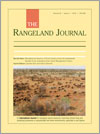
The Rangeland Journal
Volume 38 Number 2 2016
Managing the Impacts of Feral Camels across the Rangelands: Results of the Australian Feral Camel Management Project
RJ15098Feral camels: a nationally significant pest animal requiring a national management approach
Feral camel management in Australia has been guided by sophisticated scientific evidence and national policy, which have then informed investment decisions and coordinated action. The Australian Feral Camel Management Project is an example where evidence, policy and delivery have come together to deliver high quality outcomes at a continental scale. Such an approach has applicability to the management of other nationally significant established pest species.
RJ15089Effective collaboration and governance processes to underpin large-scale natural resource management projects: the Australian Feral Camel Management Project experience
Effective collaboration and governance are the foundational building blocks for successful projects in any field. There are particular challenges associated with managing a pest animal that may also be considered a resource across a large area involving many land tenures and stakeholders. Although focusing on the experiences of the Australian Feral Camel Management Project, this paper is relevant to all large-scale rangelands projects.
RJ15076Talking camels: a consultation strategy for consent to conduct feral camel management on Aboriginal-owned land in Australia
The Australian Feral Camel Management Project required informed consent from Aboriginal land owners to reduce feral camel densities in arid Australia. Aboriginal organisations consulted widely with remote communities in a way that considered the different opinions that people have on camels, and presented information clearly and consistently. The communities agreed to a variety of management options that allowed the Australian Feral Camel Management Project to reduce camel densities over three states.
RJ15082Engaging the Pastoral Industry in the Australian Feral Camel Management Project (AFCMP)
RJ15066Facilitating feral camel removal in Australia through commercial use
A removal assistance scheme was developed through the Australian Feral Camel Management Project to facilitate commercial mustering of feral camels in priority areas. The scheme’s basis was a landholder agreement that incentivised removal of both camel sexes and required adherence to best practice feral camel management in order to receive payment. The project also supported field-based pet-meating as another means of commercially driven feral camel removal.
RJ15100Planning and conducting aerial culling operations for feral camels
This paper describes the application of aerial culling to the management of feral camels during the Australian Feral Camel Management Project. It covers the following: key challenges involved, guiding principles, factors which facilitated the application of aerial culling, the planning and implementation of actual culling operations, feedback loops, and the key operational achievements of the aerial culling program.
RJ15079Integrating animal welfare into wild herbivore management: lessons from the Australian Feral Camel Management Project
Animal welfare has become an integral part of managing wild herbivores worldwide. We developed a transparent welfare auditing process for the management of a novel pest species, feral camels in Australia. We present the approach taken to animal welfare under Australian feral camel management as a lesson for other wild herbivore contexts while acknowledging the limitations of our methods.
RJ15106Measured reductions in the density of camels under the Australian Feral Camel Management Project
We provide a coarse comparison between camel density estimates derived from aerial surveys before and late in removal operations conducted during the Australian Feral Camel Management Project. The aerial surveys detected a population decline in camels over the project period that is generally consistent with camel removal activities under the project. However, the population decline in the Simpson Desert cannot be explained by the camel removal alone.
RJ15073The impact of feral camels (Camelus dromedarius) on woody vegetation in arid Australia
This paper describes the impact of feral camels on woody plants in arid Australia. It examines browsing intensity and severity (stunting and canopy loss) in 22 species of woody plants in camel-affected regions across inland Australia prior to camel removal operations. It provides quantitative information on the relationship between camel density and plant damage.
RJ15074The impact of feral camels (Camelus dromedarius) on remote waterholes in central Australia
This paper describes the impact of feral camels on remote waterholes in central Australia. It examines camel impacts on water quality/chemistry and on aquatic macroinvertebrates. It concludes that the management of large feral herbivores is a key component in efforts to conserve aquatic biodiversity in central Australia.
RJ15087Outcomes of the Australian Feral Camel Management Project and the future of feral camel management in Australia
This paper outlines the main achievements of the Australian Feral Camel Management Project in relation to reduced densities of feral camels around key environmental sites and improving capacity (knowledge, skills, equipment and infrastructure) for future feral camel management. It provides an update on ongoing feral camel management activities and emphasises the importance of maintaining the momentum of the project.



